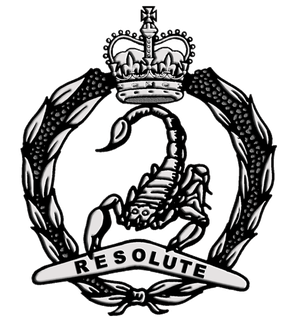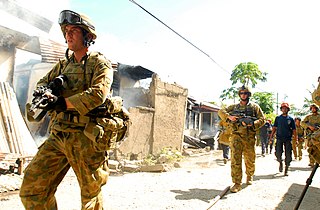
Australia joined a U.S.-led coalition in the Iraq War. Declassified documents reveal that the decision to go to war was taken primarily with a view to enhancing its alliance with the United States.

The Royal Australian Regiment (RAR) is the parent administrative regiment for regular infantry battalions of the Australian Army and is the senior infantry regiment of the Royal Australian Infantry Corps. It was originally formed in 1948 as a three battalion regiment; however, since then its size has fluctuated as battalions have been raised, amalgamated or disbanded in accordance with the Australian government's strategic requirements. Currently, the regiment consists of seven battalions and has fulfilled various roles including those of light, parachute, motorised and mechanised infantry. Throughout its existence, units of the Royal Australian Regiment have deployed on operations in Japan, Korea, Malaya, Borneo, Vietnam, Somalia, Rwanda, Cambodia, East Timor, the Solomon Islands, Iraq and Afghanistan.

The Royal Australian Armoured Corps (RAAC) is an administrative corps of the Australian Army. It provides the Australian Defence Force's Armour capability, which performs the function of mounted combat. Armour combines firepower, mobility, protection and networked situational awareness to generate shock action and overmatch in close combat. Armour is an essential element of the combined arms approach that is employed by the Australian Army.

The 2nd Cavalry Regiment is an armoured cavalry regiment of the Australian Army. Formed in 1965 as the "1st Cavalry Regiment", it is the second most senior regiment in the Royal Australian Armoured Corps. In 1970, the regiment was redesignated as the "2nd Cavalry Regiment", to differentiate it from the 1st Armoured Regiment. The regiment was based at Holsworthy until 1992 when it was allocated to the 1st Brigade based in Darwin in the Northern Territory. In late 2014 the regiment was transferred to the 3rd Brigade, and is now based in Townsville in Queensland. The unit is equipped with M1A1 tanks, ASLAV light armoured vehicles and M113AS4 APCs.

The 3rd/4th Cavalry Regiment is an armoured unit within the Australian Army's Royal Australian Armoured Corps. Formed in 1981 with the amalgamation of the 3rd Cavalry Regiment and the 4th Cavalry Regiment, from 1986 to 2014 the unit consisted of an independent squadron, B Squadron 3rd/4th Cavalry Regiment, within the 3rd Brigade in Townsville, Queensland. From 2017, B Squadron 3rd/4th Cavalry Regiment has been the training support and logistics squadron within the School of Armour at Puckapunyal in Victoria.

The Australian Light Armoured Vehicle (ASLAV) is an eight-wheeled armoured reconnaissance vehicle of the LAV II family used by the Australian Army. It was built by General Dynamics Land Systems Canada, and developed from the U.S. Marine Corps' LAV-25 and Canadian Army's Bison armoured fighting vehicles.

The 2nd/14th Light Horse Regiment is a regiment of the Australian Army and forms part of the Royal Australian Armoured Corps. The regiment is an Australian Light Horse unit, and has been widely romanticised and popularised in literature and poetry throughout the 20th century. The unit sentimentally traces its lineage to 1860 and is the oldest Australian Regular Army unit through antecedent units the 2nd Moreton Light Horse (QMI) and the 14th West Moreton Light Horse (QMI). The regiment is assigned to 7th Brigade based in Brisbane and is equipped with the Boxer Combat Reconnaissance Vehicle, the ASLAV Reconnaissance Vehicle and the M1A1 Abrams main battle tank.
The history of the Australian Army is the culmination of the Australian Army's predecessors and its 120-year modern history. The Army has its origins in the British Army and colonial military forces of the Australian colonies that were formed prior to the Federation of Australia. These were gradually united into federal units between 1899 and 1903; thus forming the beginning of the Australian Army. The colonial forces were combined and formed the basis of the new army, when the Commonwealth of Australia was founded on 1 January 1901. The modern history of the Army began with its founding at the start of the 20th century as the colonial armies were officially united as the Commonwealth Military Forces. In 1916 the title 'Australian Military Forces' was adopted and remained its official name until 1980, after which it became known as the Australian Army.

This article describes the current structure of the Australian Army. It includes the army's order of battle and the headquarters locations of major units. Members of the Australian Army also serve within joint units of the Australian Defence Force which fall outside the direct command of the Australian Army.

The Al Muthanna Task Group (AMTG) was a battlegroup that formed Australia's main ground force contribution to the Multinational force in Iraq. The AMTG was established in April 2005 and ceased to exist in July 2006 when the Australian force was relocated to Dhi Qar Governorate as Overwatch Battle Group (West).

The 3rd Brigade is a combined arms brigade of the Australian Army, principally made up of the 1st and 3rd Battalions of the Royal Australian Regiment. Initially raised in 1903 as part of the post-Federation Australian Army, it was removed from the order of battle in 1906 following the restructure of the field force. It was re-formed in 1914 for service during World War I, taking part in the fighting at Gallipoli and on the Western Front in Europe. During World War II the brigade was used in a defensive role before it was disbanded in 1944. It was re-raised in 1967 for service during the Vietnam War and later went on to provide the nucleus of the deployment to East Timor during the Australian-led intervention in 1999. The brigade is currently based at Lavarack Barracks in Townsville, Queensland.

The 5th/7th Battalion, The Royal Australian Regiment (Mechanised) was a mechanised infantry battalion of the Australian Army. The battalion was based at Robertson Barracks in Holtze, Northern Territory and formed part of the 1st Brigade. It was formed in 1973 by linking both the 5th and 7th Battalions of the Royal Australian Regiment together and was disbanded 3 December 2006, as part of the expansion of the Australian Army, when the 5th and 7th Battalions of the Royal Australian Regiment were delinked into two separate battalions once again.

Operation Astute was an Australian-led military deployment to East Timor to quell unrest and return stability in the 2006 East Timor crisis. It was headed by Brigadier Bill Sowry, and commenced on 25 May 2006 under the command of Brigadier Michael Slater. The operation was established at the request of East Timor's government, and continued under an understanding reached between Australia, East Timor, and the United Nations, with the United Nations Integrated Mission in East Timor supporting and helping to develop East Timor's police force. Other countries deploying soldiers to East Timor include Malaysia, New Zealand and East Timor's former colonial power Portugal, operating under independent command.

Below is an estimated list of the major units deployed within the Multi-National Force – Iraq and other United States military units that were operating in Iraq under the U.S. Central Command (USCENTCOM) in 2009, during the Iraq War.
Multi-National Division (South-East) was a British commanded military division responsible for security in the south east of Iraq from 2003 to 2009. It was responsible for the large city of Basra and its headquarters were located at Basra Airport. The division was initially responsible for the governorates of Al Muthanna, Maysan, Basra, and Dhi Qar. MND-SE was a subordinate division of Multi-National Corps Iraq. Multi-National Corps Iraq was itself part of Multi-National Force-Iraq.

The 5th Battalion, Royal Australian Regiment is a regular motorised infantry battalion of the Australian Army. Originally established in 1965 it would serve two tours of South Vietnam before it was linked with the 7th Battalion to form the 5th/7th Battalion, Royal Australian Regiment in 1973. In late 2006 the two units were de-linked, and 5 RAR again joined the Australian Army's order of battle in its own right. It has since served in Iraq, East Timor and Afghanistan.
The ANZAC Battle Group was an Australian-led battle group deployed to Timor Leste as part of Operation Astute. The battle group was established in September 2006 and comprised several rifle companies, including a company from the New Zealand Army, and sub-units of other Australian Army units.

The 151st Cavalry Regiment was a United States Army cavalry regiment represented in the Arkansas Army National Guard by 1st Squadron, 151st Cavalry Regiment, headquartered in Warren, Arkansas, an element of the 39th Infantry Brigade Combat Team.
The 7th Combat Service Support Battalion is an Australian Army administration and logistics battalion which provides transport, supply and maintenance support services to units of the 7th Brigade. The battalion is made up of both Regular personnel and has recently been involved in deployments to Timor Leste, Iraq and Afghanistan.

Major General Justin Frederick Ellwood,, commonly known as Jake Ellwood, is a retired senior officer of the Australian Army. He joined the army via the Royal Military College, Duntroon in 1989 and was commissioned into the Royal Australian Infantry Corps. He commanded the 5th Battalion, Royal Australian Regiment (2006–08), Overwatch Battle Group (West) (2007), Battle Group Tiger (2008) and the Combat Training Centre, and deployed on operations to Kosovo, East Timor, Iraq and Afghanistan. He served as Deputy Chief of Army from May to December 2018, and commanded the 1st Division from December 2018 to November 2021.















